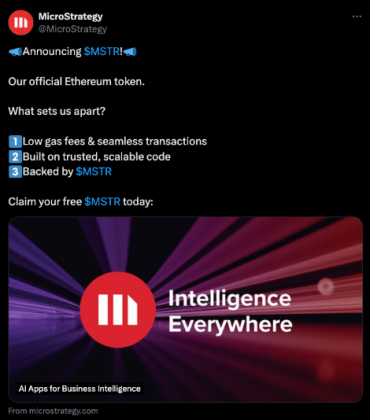MicroStrategy X Account Hacked In Elaborate Ethereum Token Scheme – Details

The crypto community is once again on high alert after hackers compromised the official X account (previously known as Twitter) of business intelligence firm MicroStrategy. The attack, which took place on Monday morning, involved the distribution of malicious links promoting a fake airdrop of a non-existent “MSTR” token based on the Ethereum blockchain.
Unwary users who clicked on the links were directed to a fraudulent webpage designed to mimic MicroStrategy’s legitimate platform. The webpage then prompted users to connect their crypto wallets, granting the attackers the necessary permissions to drain their holdings.

MicroStrategy: A Target For Crypto Scammers
This is not the first time MicroStrategy has been targeted by malicious actors attempting to exploit its established reputation and loyal following. In 2022, the company’s CEO, Michael Saylor, was impersonated on social media to promote a fake cryptocurrency giveaway.
According to blockchain sleuth ZachXBT and anti-scam platform Scam Sniffer, the losses from this elaborate scam have already surpassed $440,000, with one individual losing a staggering $420,000 worth of various altcoins.
there was a second best after all
(hacked acc if not obvious lol) pic.twitter.com/cdLqbqiiCO
— Spreek (@spreekaway) February 26, 2024
This latest incident highlights the growing trend of hackers utilizing compromised accounts of trusted individuals and companies within the crypto space to manipulate user trust and steal their digital assets.
someone lost $424,786 worth of $wBAI, $wPOKT, and $CHEX to phishing scams about 5 minutes ago. pic.twitter.com/GEJvHEXuM7
— Scam Sniffer | Web3 Anti-Scam (@realScamSniffer) February 26, 2024
A Pattern Of Social Media Exploits In The Crypto Industry
Unfortunately, this attack is just one example of a larger pattern plaguing the crypto industry. In January 2023, the X accounts of the US Securities and Exchange Commission (SEC) and cryptocurrency data aggregator CoinGecko were also compromised, resulting in the spread of misinformation and attempts to lure users into phishing scams.
Additionally, in the same year, hackers targeted the X account of Ethereum co-founder Vitalik Buterin, using it to promote a fraudulent ConsenSys link and swindling close to $700,000 from unsuspecting followers.
These incidents showcase the vulnerability of social media platforms to phishing attacks and the need for users to exercise extreme caution when interacting with online promotions, particularly those promising free tokens or rewards.
Experts recommend verifying the legitimacy of any information before clicking on links or connecting wallets, especially when the source appears to be a trusted individual or organization.
MicroStrategy Remains Silent On The HackAs of now, MicroStrategy has not issued any official statement regarding the recent hack of its X account. This lack of communication could potentially be interpreted as negligence or difficulty in containing the situation.
Featured image from Pexels, chart from TradingView
MicroStrategy X Account Hacked In Elaborate Ethereum Token Scheme – Details

The crypto community is once again on high alert after hackers compromised the official X account (previously known as Twitter) of business intelligence firm MicroStrategy. The attack, which took place on Monday morning, involved the distribution of malicious links promoting a fake airdrop of a non-existent “MSTR” token based on the Ethereum blockchain.
Unwary users who clicked on the links were directed to a fraudulent webpage designed to mimic MicroStrategy’s legitimate platform. The webpage then prompted users to connect their crypto wallets, granting the attackers the necessary permissions to drain their holdings.

MicroStrategy: A Target For Crypto Scammers
This is not the first time MicroStrategy has been targeted by malicious actors attempting to exploit its established reputation and loyal following. In 2022, the company’s CEO, Michael Saylor, was impersonated on social media to promote a fake cryptocurrency giveaway.
According to blockchain sleuth ZachXBT and anti-scam platform Scam Sniffer, the losses from this elaborate scam have already surpassed $440,000, with one individual losing a staggering $420,000 worth of various altcoins.
there was a second best after all
(hacked acc if not obvious lol) pic.twitter.com/cdLqbqiiCO
— Spreek (@spreekaway) February 26, 2024
This latest incident highlights the growing trend of hackers utilizing compromised accounts of trusted individuals and companies within the crypto space to manipulate user trust and steal their digital assets.
someone lost $424,786 worth of $wBAI, $wPOKT, and $CHEX to phishing scams about 5 minutes ago. pic.twitter.com/GEJvHEXuM7
— Scam Sniffer | Web3 Anti-Scam (@realScamSniffer) February 26, 2024
A Pattern Of Social Media Exploits In The Crypto Industry
Unfortunately, this attack is just one example of a larger pattern plaguing the crypto industry. In January 2023, the X accounts of the US Securities and Exchange Commission (SEC) and cryptocurrency data aggregator CoinGecko were also compromised, resulting in the spread of misinformation and attempts to lure users into phishing scams.
Additionally, in the same year, hackers targeted the X account of Ethereum co-founder Vitalik Buterin, using it to promote a fraudulent ConsenSys link and swindling close to $700,000 from unsuspecting followers.
These incidents showcase the vulnerability of social media platforms to phishing attacks and the need for users to exercise extreme caution when interacting with online promotions, particularly those promising free tokens or rewards.
Experts recommend verifying the legitimacy of any information before clicking on links or connecting wallets, especially when the source appears to be a trusted individual or organization.
MicroStrategy Remains Silent On The HackAs of now, MicroStrategy has not issued any official statement regarding the recent hack of its X account. This lack of communication could potentially be interpreted as negligence or difficulty in containing the situation.
Featured image from Pexels, chart from TradingView

